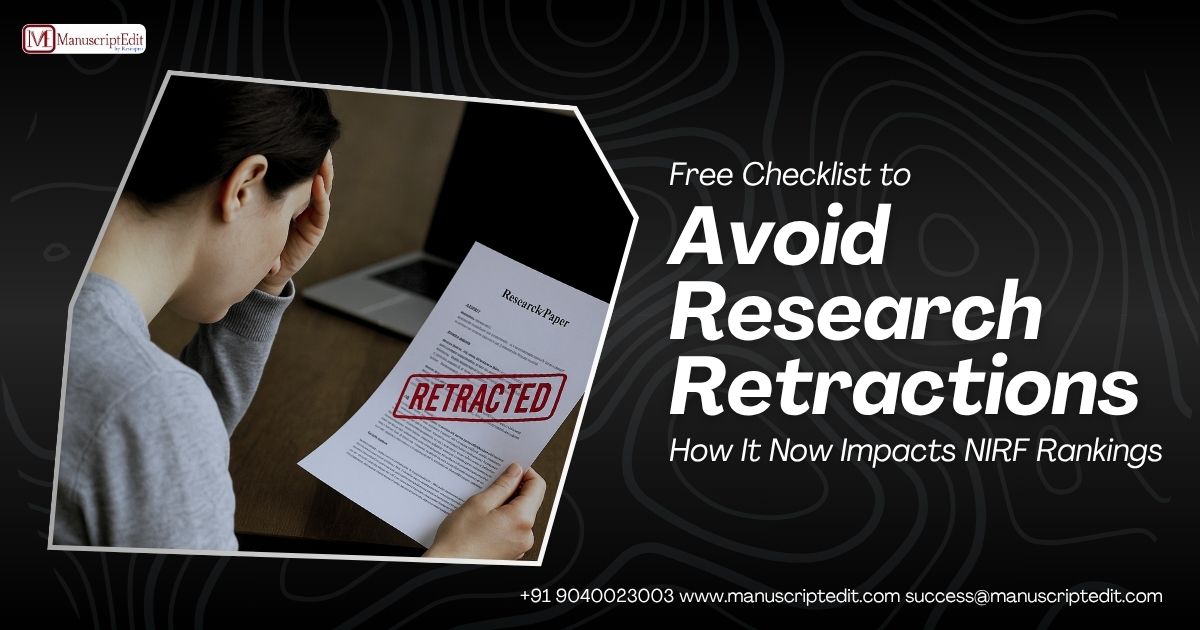
Retractions Are No Longer Harmless — They Now Hit NIRF Rankings
In June 2025, the Research Integrity Risk Index (RI²), developed by bibliometrician Lokman Meho, red-flagged 35 Indian universities—including Saveetha, KL, and Graphic Era—for publishing in retracted or delisted journals. NAAC’s executive chairperson later confirmed that such retractions will now negatively impact an institute’s NIRF rank. With retractions rising across Indian biomedical publications (Sharma et al., 2023), authors and institutions must now prioritise research integrity. Beyond India, global rankings like THE and QS now examine retraction rates and data transparency, especially from high-submission countries. Universities across Delhi, Bangalore, and Pune are under pressure to ensure every journal publication meets ethical benchmarks. This blog presents a free, research-backed checklist to help you reduce retraction risk and safeguard your academic reputation.
Why Retractions Hurt NIRF
According to ThePrint (2025), NAAC has begun assigning negative marks to institutions with repeated retractions. This aligns with concerns flagged by the Nature-published RI² Index that labelled India as a high-risk zone for research misconduct. Sharma et al. (2023) found 619 Indian biomedical papers were retracted between 1990 and 2021. The leading causes were plagiarism (27%), falsification (26%), and duplicate publications (21%). Notably, 82% of these papers continued to be cited post-retraction. Retractions, once treated as isolated errors, now reflect systemic academic lapses—impacting institutional ranking, grant approvals, and student admissions under NIRF metrics. NAAC’s audit panels now use retraction records and delisting alerts from Crossref and Scopus during accreditation reviews. A single retraction in a flagship department can prompt a full research audit.
Free Checklist – 7 Steps to Prevent Retractions
Retractions are preventable if authors adopt rigorous standards from the start. Below is a condensed version of our universal checklist to avoid retractions. You can download the complete version using the button below.

1. Authorship Ethics: Define roles and gain consent from all co-authors.
2. Plagiarism & AI Check: Use Turnitin and GPT detectors before submission.
3. Data Transparency: Ensure raw data and statistics are verifiable.
4. Proper Journal Targeting: Avoid predatory or delisted journals; verify with UGC CARE and Scopus.
5. Technical & Formatting Accuracy: Follow the journal’s exact author guidelines.
6. Ethical Approvals: Secure IRB/ethics approvals where needed.
7. Pre-submission Review: Have experts critically review the manuscript.
8. Keep Journal Proof: Always retain screenshots or emails confirming submission to UGC-approved or indexed journals.
Special Offer: Pre-Submission Peer Review by ManuscriptEdit for ₹8000
Includes Turnitin plagiarism check, AI content scan, grammar & style edit, technical compliance review, and content clarity feedback.

Cost of Poor Research: Is It Hard to Publish a Journal?
Retractions harm more than just reputations—they disrupt careers. A single mistake can blacklist an author, damage an institution’s ranking, and lead to funding losses. While many ask if journal publication is hard, the truth is that poor preparation makes it riskier. Moylan & Kowalczuk (2016) showed that most retractions stem from correctable issues: authorship disputes, data errors, unethical duplication. Even well-written articles face retraction if basic standards are ignored. Institutions also suffer when their researchers get flagged—funding proposals, student exchange partnerships, and international research collaborations can all be jeopardised. The checklist is your first line of defence.
How to Use the Checklist Effectively
Use the checklist at two key points: (1) before journal submission, and (2) before internal review or presentation. Start by verifying originality using plagiarism tools like Turnitin, then run the manuscript through AI-detection tools like GPTZero. Conduct a citation quality audit—remove fake or irrelevant references. Ensure ethics approvals are in place for studies involving human/animal subjects.
A game-changer is pre-submission peer review. It mirrors journal scrutiny and flags critical flaws early. ManuscriptEdit offers this expert service for ₹8000, including a Turnitin report, AI content audit, grammar & formatting polish, technical checks, and content logic review. Several Indian institutions now conduct internal retraction-risk audits using this checklist before allowing submissions from faculty or PhD students. [Insert Offer Here]
FAQs – Your Questions Answered
• What is indexing? It means your journal is listed in trusted databases like Scopus, PubMed, or Web of Science.
• What are UGC approved journals? These are vetted by UGC CARE—check the latest list before submission.
• How much are publication fees? Varies widely. Different journals have different article processing charges with different options.If you need, Manuscriptedit can help you in providing journal selection report to suit your need ( Free as well as hybrid journals non-predatory indexed journals).
• What if my journal gets delisted? Your article loses recognition and may be flagged under RI²-based audits.
• How many retractions are too many? There’s no fixed number, but repeat authors often face permanent bans.
• Can I fix a retraction? Some journals allow corrections, but the stain on credibility often remains.
Conclusion: Don’t Wait Until It’s Too Late
Retractions now carry NIRF and NAAC consequences. Use the checklist, book a pre-submission review, and publish responsibly.




